Acting as steward of a historic home is both rewarding and challenging. Homeowners simultaneously take great joy in restoring historic houses and stress about the issues a renovation might uncover. Navigating rules set by your local commission and determining which additions to retain or replace can make a historic home renovation more complex. Historic home restoration can be far more costly and time-consuming than remodeling a regular fixer-upper or updating a newer build. However, the value of either restoring a historic home or updating it to meet the needs of a modern family cannot be understated. By assembling the right team and seeking guidance from the right sources, Houston homeowners can remodel or restore historic properties with confidence. Before you start, read through our list of do’s and don’t’s for historic home renovation.
Do’s and Don’ts of Historic Home Restoration & Remodeling
As noted briefly above, renovating a historic house is a far different experience than renovating other “old houses.” Depending on your home’s history, local, state and federal laws could prevent you from making cosmetic and/or structural changes. Homeowners must take special care to observe all laws that apply to their properties — even when those rules might delay or refactor one’s plans.
After all, these rules are set to prevent loss or obfuscation of our shared history and cultural heritage. Working closely with your Historic Preservation Commission ensures all renovations are executed legally and with respect to the history of your home. Beyond consulting your local and state Historic Preservation Office, here are more do’s to follow and don’t’s to avoid when remodeling a historic home.
When Remodeling a Historic House DO…
Learn About Your Home’s History
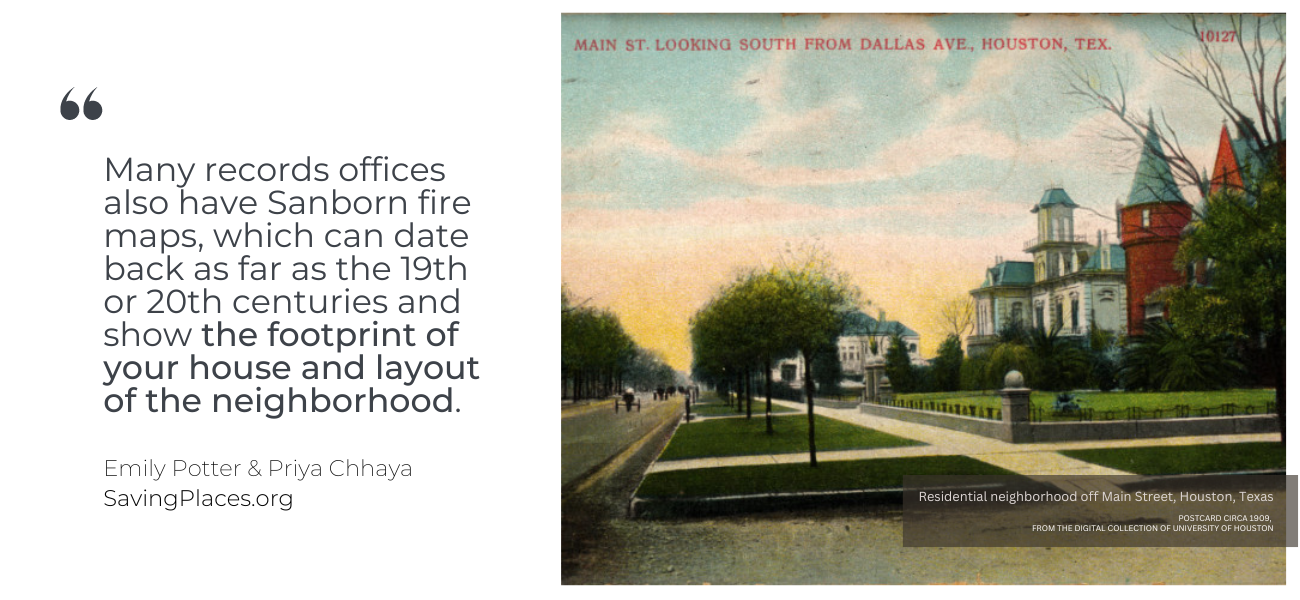
When remodeling a historic building, DO learn about your home’s history. Research its architectural styles and interior, learn about the neighborhood’s history and figure out how it compares to others in its historic district.
In a resource for Saving Places by the National Trust for Historic Preservation, Emily Potter and Priya Chhaya explain how to research historic homes. To uncover the hidden history of your home, look for builder stamps and vestiges of old wallpaper in storage spaces like attics and closets.
Chat with homeowners in your neighborhood and other historic districts before starting your historic home restoration. Visit City Hall or your county assessor’s office for property records decades back or “look up local census data” online. Chhaya and Potter recommend reaching out to your town’s historical society or public library for further information.
Set Goals for Your Project
When remodeling historic homes DO set goals for your project — starting with how you plan to use the property. Will you live in the home? Do you want to use the main house or detached buildings as rental units? Are you planning to restore or rehab the property?
Identifying your goals for the project will help you communicate with a design firm, builders and the planning commission. Depending on the scope and intention of your project, it might also qualify for tax breaks.
Determine Whether Remodeling Might Be Restricted Due to Historical Significance or Age
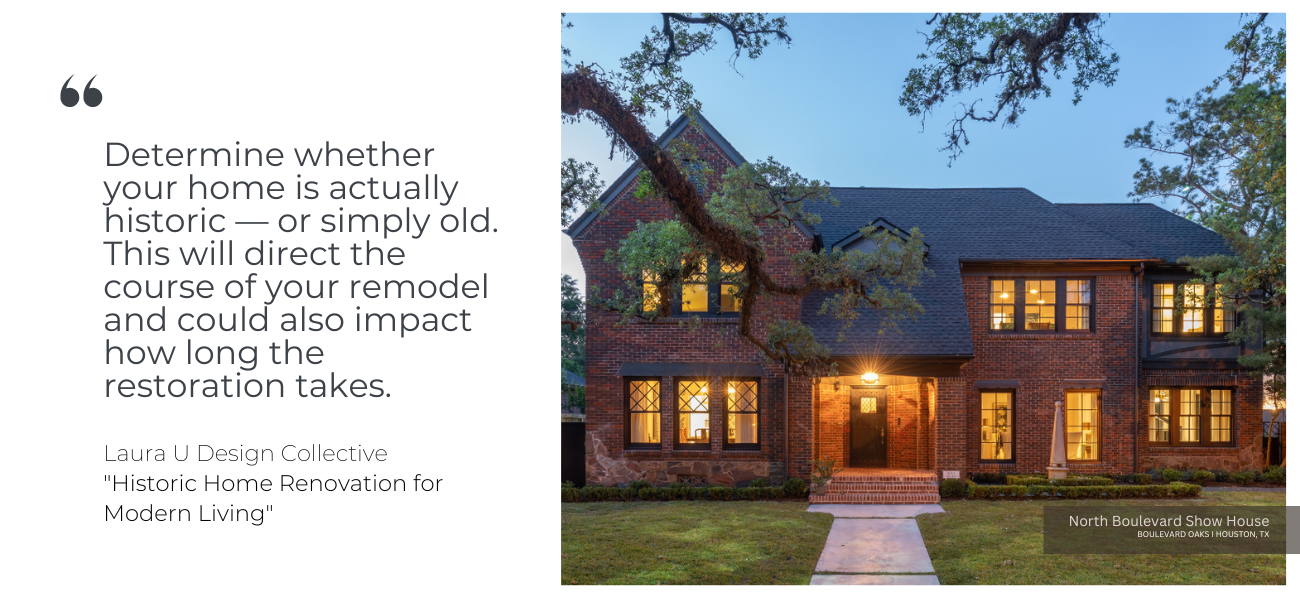
DO determine whether remodeling might be restricted due to historical significance or age. As we note in this post, you must “determine whether your home is actually historic — or simply an old house” before proceeding. Your home’s age and/or significance will direct the course of your remodel. These factors could also impact how long the renovation takes.
Bear in mind that a home need not be a certain age to be historic. Some homes are relatively young, but meet one or more additional criteria set by your local commission, and are granted historic status.
Your home might be historic because of its age or architectural style. However, it could also be historic if a significant event occurred there or a person of note lived in the home. If your home is deemed historic, your ability to alter the home might be limited.
Take Care to Preserve Historic Documents
DO take care to preserve historic documents. Upon purchasing your home — or while researching the property — you might come across important documents, photos and other artifacts tied to its history. Whether work orders or family photos, keep each of these documents in a safe place. If you cannot unroll or otherwise open documents related to your home’s history, contact a conservator for help.
Work with an Architectural Historian
DO work with an architectural historian to identify later additions to the home. An architectural historian will help craft a timeline of your home’s initial construction and subsequent repairs or additions. This is important when planning to either adapt the house to modern living or return it to its original form and function.
Major changes made to the original layout of your home might allow for further modernization. However, some additions that do not belong to the period of construction might be historic in their own right. An architectural historian will help you evaluate the significance of later additions, so you do not make ill-fated and irreparable alterations to the home.
Make the Home More Accessible
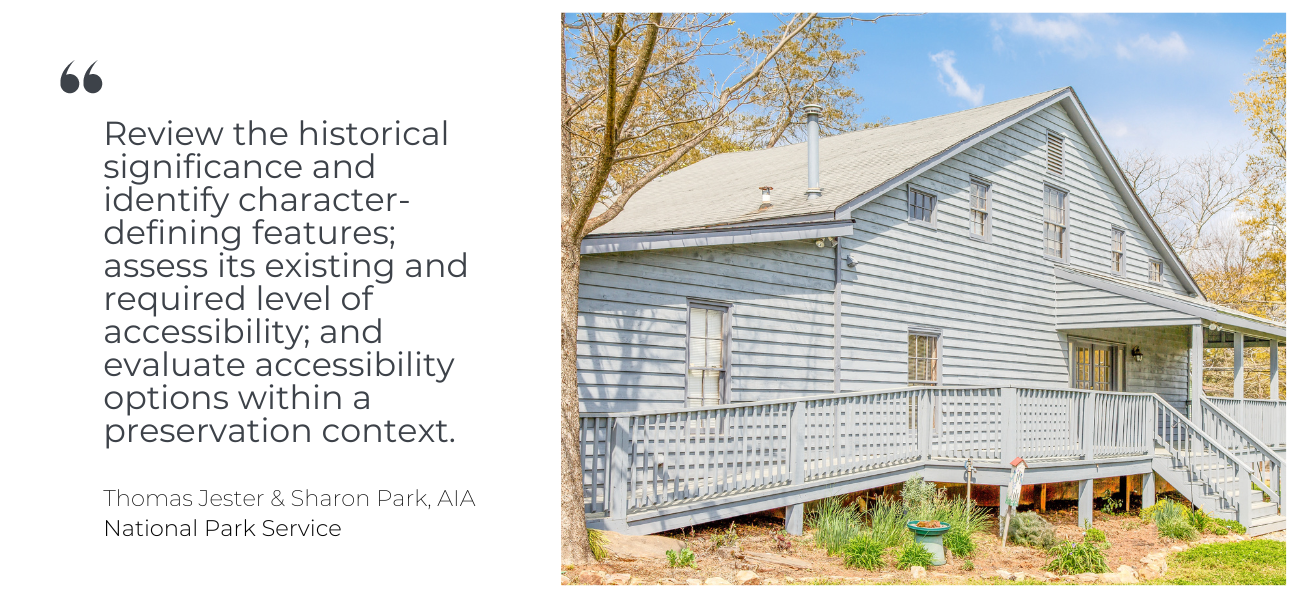
DO make the home more accessible for seniors aging in place and differently-abled guests or residents. The National Trust for Historic Preservation and other organizations provide guidance regarding accessibility updates to historic properties.
There are many ways to enhance accessibility without threatening your home’s unique character. Consult this resource from the National Park Service for more information.
Upgrade Building Systems for Safety, Functionality and Efficiency
DO upgrade building systems to improve efficiency and correct health or safety issues. Working with a residential design firm that has experience renovating historic homes will ensure your property is brought up to current building codes. A design team can also help you make electrical, plumbing and HVAC systems more efficient than the historical versions currently installed.
Consult Historic Wallpaper and Paint Collections
DO reference historic wallpaper and paint collections. Many museums, heritage societies and archives preserve historic wallpaper, paint and other interior decoration. Designers, conservators and homeowners can consult these collections when restoring historic homes.
Some manufacturers create replicas of antique and vintage wallcoverings specifically for this purpose. Reach out to your local heritage society or regional archive for guidance — or peruse online collections.
Submit a Historic Property Damage Report if Relevant
DO submit a Historic Property Damage Report if relevant. If your historic home suffered damage or loss during a recent natural disaster, file the appropriate paperwork with local, state and federal authorities. You might qualify for tax credits, financial aid from FEMA or expedited approval to make emergency repairs.
Educate Yourself
DO educate yourself about the historic home renovation and restoration processes. One of our favorite texts about historic house restoration is Scott T. Hanson’s Restoring Your Historic House. As it covers dozens of important topics, we will reference Hanson’s book multiple times throughout the course of this post.
Understand the Difference Between Restoring and Remodeling
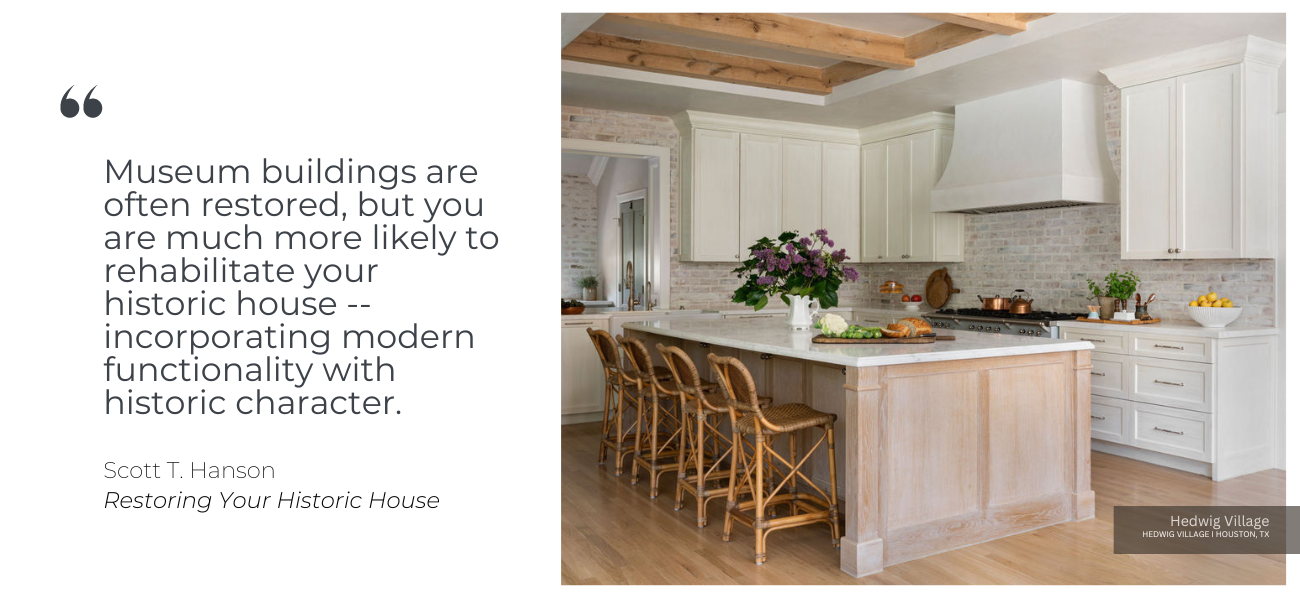
DO differentiate between restoring and remodeling your historic home. As Hanson writes in Chapter Two of Restoring Your Historic House , “a restoration project returns a historic building to its original structure and form.” A restoration does “not adapt a building to…new ways of living.”
However, restoration and remodeling can be lumped together under the term “historic preservation.” As it governs historic preservation in your community, rules set by your planning commission will likely apply to both approaches. Consult this resource from the NTHP’s Saving Places before deciding whether to restore or rehabilitate your home.
Prioritize Preserving Elements That Truly Reflect the Period
DO prioritize elements that truly reflect the period in which your home was built. Hanson calls these elements “character-defining features.” It is especially important to preserve rare elements and those that are unique to your specific home or the area to which it belongs.
Consider Living Elsewhere During the Renovation
DO consider living elsewhere during the renovation for the health and safety of your family. Remodeling a historic home can dig up dangerous materials, animal waste, dangerous electrical wiring and other issues.
Living off-site prevents your family from being exposed to chemicals, rotted building materials, mold and so much more. Plus, you can avoid the hassle of trying to live your daily lives amid the noise and dust of demolition, construction and installation.
Make it Functional While Honoring its History
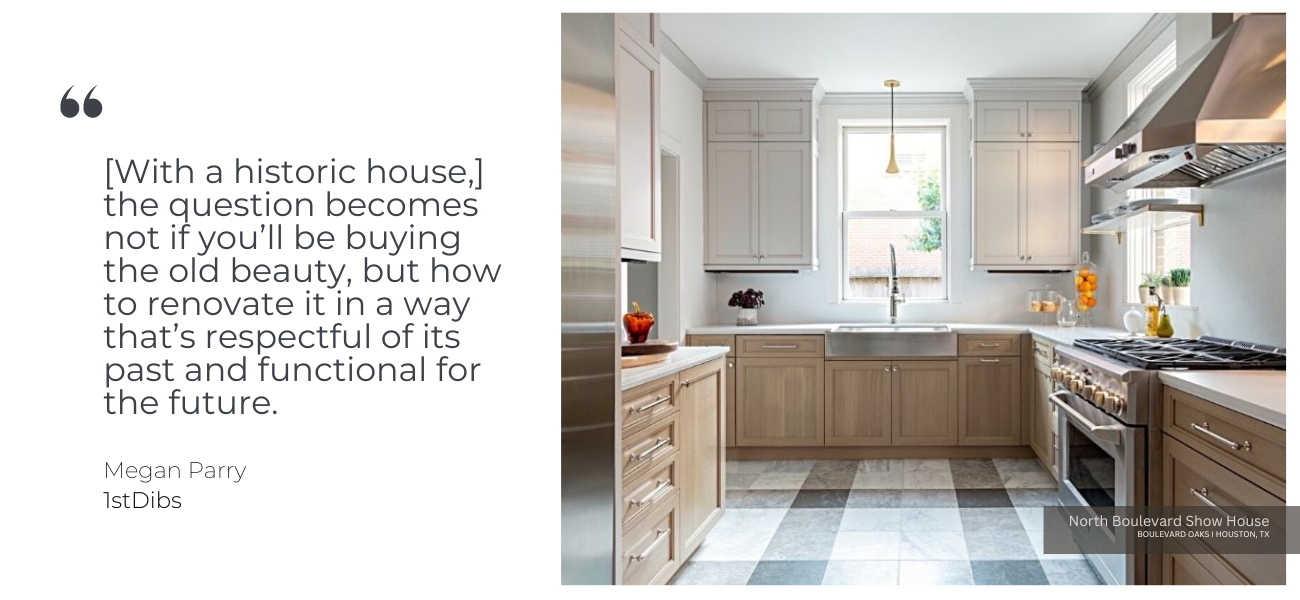
Particularly if rehabbing your home rather than restoring it, DO make the home functional while honoring its history. As Megan Parry details in this post for 1stDibs, the antique layouts of historic homes can be adapted to suit modern ways of life.
Quoting David Powell of Powell and Bonnell, Parry writes that spaces can be expanded or even relocated without disrupting the character of the home. Powell notes that rooms must be “‘adapted to fit within the existing envelope.'” Alternatively, they can be “‘attached’ to the architectural envelope, [but] treated in a traditional manner.'”
With attention to detail and respect for the home’s history, either approach can honor its past while serving the family that now occupies it.
When Remodeling Historic Homes DO NOT…
Start Without Consulting Experts in Your Area
When remodeling a home in a historic district, DO NOT start without consulting experts in your area. Each architectural style has certain characteristics that remain consistent from one town to the next. However, architects from each region add their own flair. Some of these local additions are particularly significant.
As such, the guidance of a local historian is vital to properly preserving your historic home. A local expert will also ensure you submit all the right documents, meet key deadlines and follow all laws.
Expect to Sail Through the Review Process
DO NOT expect to sail through the review process. The amount of time and effort it takes to navigate the approval process varies from city to city. Some districts allow for a period of public comment after hearing a homeowner’s plans to rehab or restore his or her historic property.
Depending on your plans, the process could take a few weeks — or it could take months. For example, altering the home’s exterior appearance or addressing structural problems might attract more attention from local officials than updating the interior.
Set a Budget Based on Modern Fixer-Upper Remodeling Costs
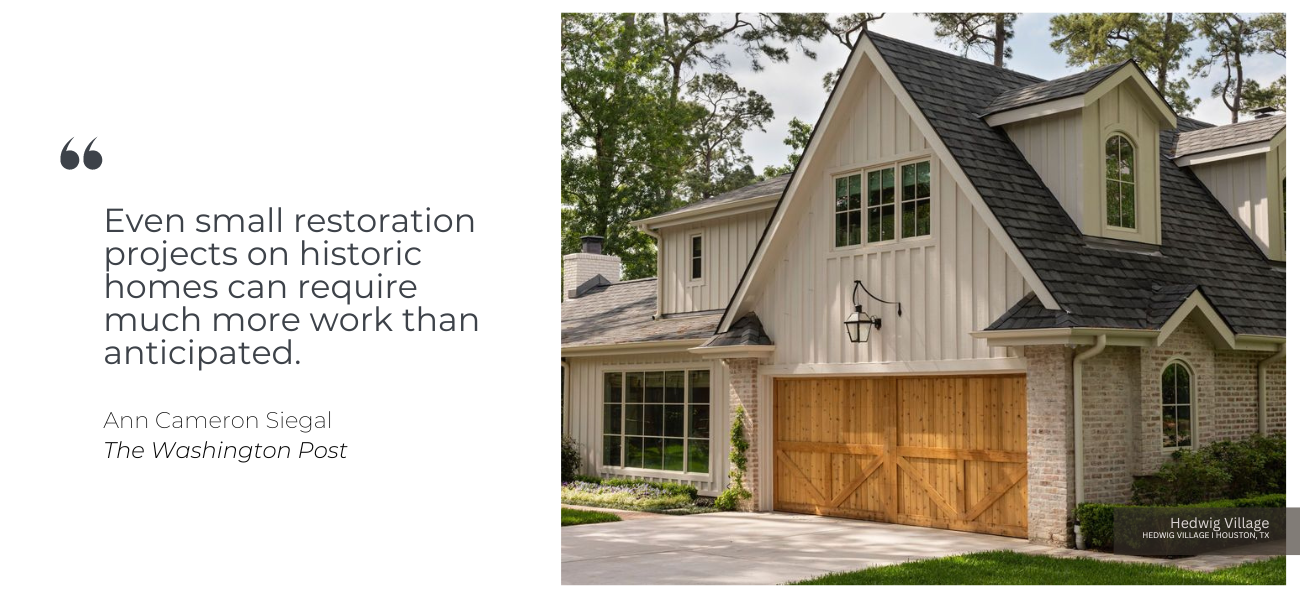
DO NOT set a budget based on modern fixer-upper remodeling costs. Remodeling a historic home can uncover a whole host of issues — from water damage and dry rot to electrical issues and illegal additions.
Ann Cameron Siegal hammers this point home in an article for The Washington Post. Siegal writes that “even small restoration projects on historic homes can require much more work than anticipated.” Prepare yourself for a longer, more complex process — and an incredibly rewarding final result!
Assume That Grants and Tax Incentives Will Not Apply to You
DO NOT assume that grants and tax incentives are relegated to institutions like museums, commissions and other nonprofits. Certain grants, tax credits, tax deductions and easements are available to individual homeowners who seek to preserve historic properties.
The National Trust for Historic Preservation, National Park Service and the federal tax code provide money-saving opportunities to homeowners. Some local businesses, state governments, private companies and foundations offer financial aid to historic homeowners too.
Make Major Stylistic Changes to the Exterior
DO NOT make major stylistic changes to your home’s exterior without permission from the planning commission. It is typically easier to get approval for interior updates, upgrades or repairs than it is to alter the exterior of a historic home. Most planning commissions allow you to make more significant changes to the home’s exterior if it faces inward and not towards a public street.
Rule Out New Uses for Old Spaces

DO NOT rule out new uses for existing spaces in your antique or vintage home. The needs of modern homeowners differ from those of our ancestors. Historic planning commissions often recognize the needs of today’s homeowners, and will support alterations that do not disrespect the home’s history. Consult your design team and local council if planning to convert older buildings for use as ADUs or entertaining space.
Neglect the Grounds
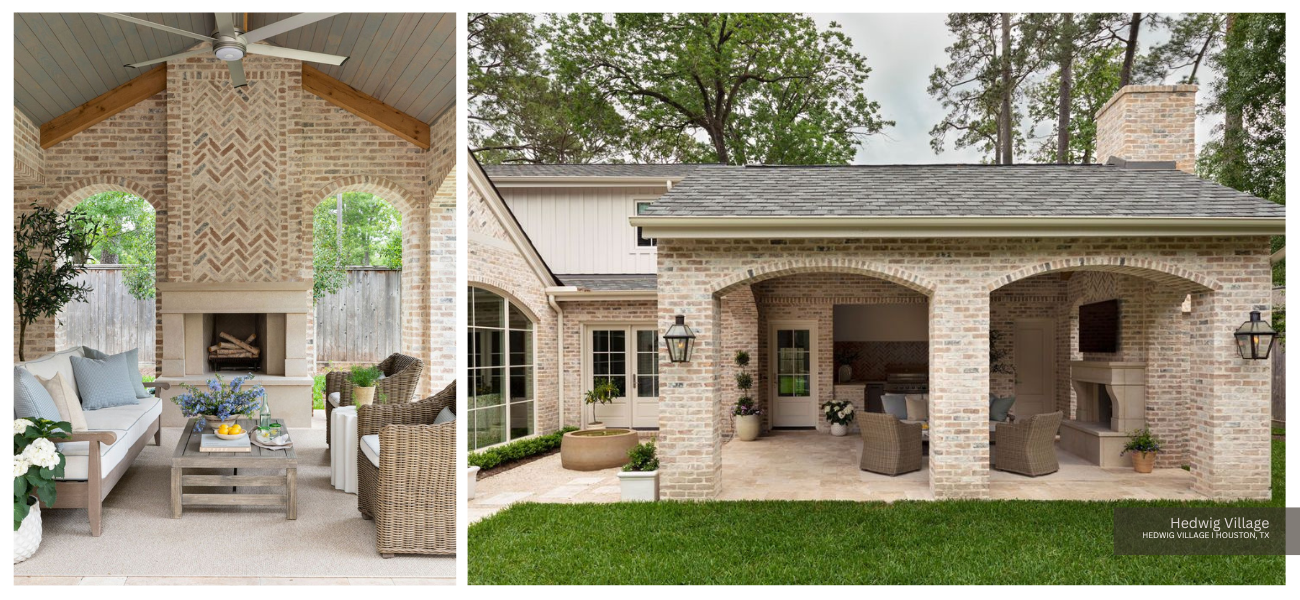
DO NOT neglect the grounds, as they can communicate your home’s history too. Work with a landscape architect to update drainage or bring gardens back to life. Consult a historian and/or conservator to restore historic gates, loggia and other structures across the property.
Automatically Assume That Modern Fuel Sources Are Off-Limits
DO NOT assume that modern fuel sources and energy-efficient appliances are incompatible with your historic home. In fact, homeowners can often convert wood or coal-burning fireplaces to gas, add solar panels or switch to geothermal heating and cooling.
Of course, not all updates are on the table. Robert Khederian elaborates in an article for Curbed . He notes that “‘you’re going to buy a historic house because you love the old wavy glass windows and the spirit of the floors.'” If you buy a historic house for these special qualities, you might have to sacrifice “‘some of the creature comforts [of] 21st century living.'”
Assume Your House is Not on the National Register of Historic Places
DO NOT assume the lack of a plaque means your home is not on the National Register of Historic Places. Research your home before planning a rehab or restoration.
A spot on the National Register of Historic Places can limit your options for a remodel. However, it can increase resale value and help you secure grants for repairs. It could also boost your property’s reputation if you hope to use the property as an event venue or short-term rental.
Wantonly Replace Older Doors and Windows
DO NOT wantonly replace older doors and windows. One common misconception is that older windows and doors are drafty, inefficient and in desperate need of replacement. In reality, newer windows with plastic and rubber parts are more likely to fail than well-kept wood and glass windows.
In an article for This Old House , Preservation Consultant John Leeke explains. Leeke writes that “thirty percent of windows being replaced are less than 10 years old.” While some old windows must be replaced, others can be treated — or even left alone. Work with a preservation consultant, historian or other expert to determine the condition and adaptability of your home’s windows and doors.
Ready to Restore or Remodel Your Historic Houston Home?
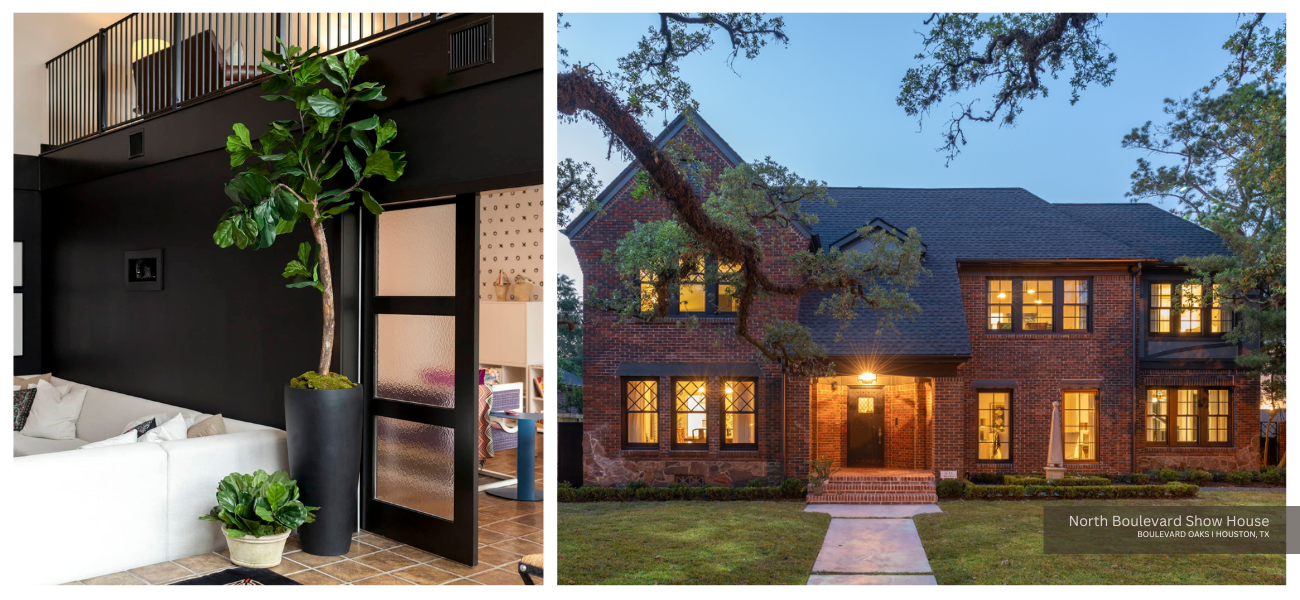
From North Boulevard to Hedwig Village, our residential design team has remodeled several distinctly “Houston” historic homes. Reach out to the team here, and read through our post ” Historic Home Renovation for Modern Living” for more information.


